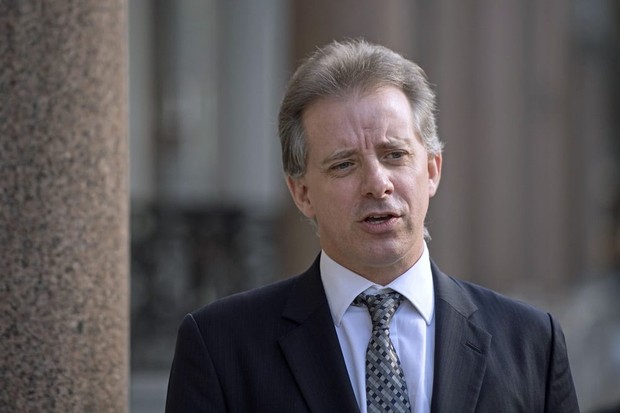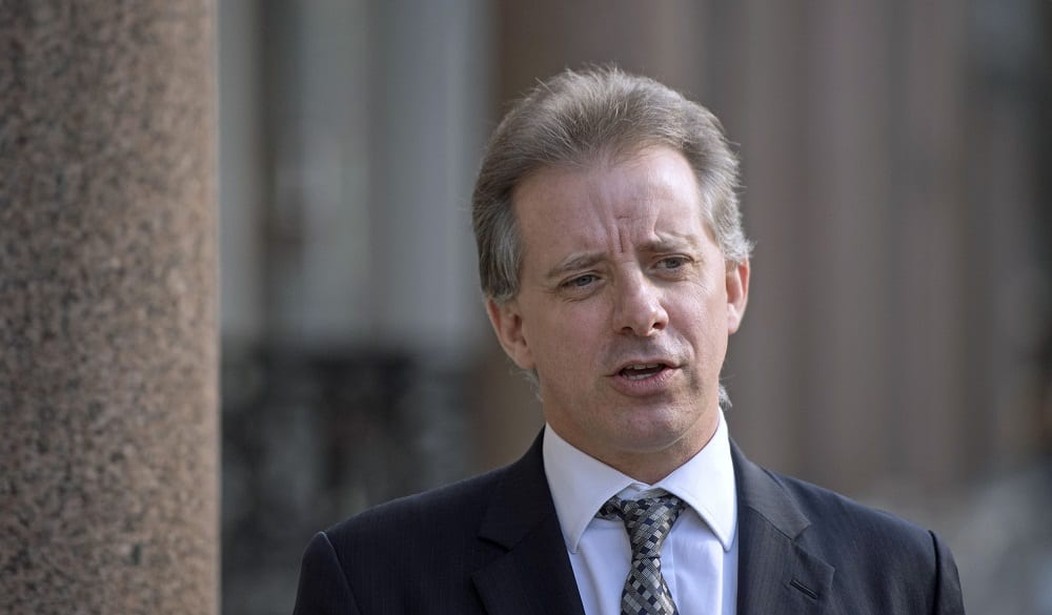
Former British intelligence officer Christopher Steele, in London on Tuesday March 7, 2017, where he has spoken to the media for the first time. Steele who compiled an explosive and unproven dossier on President Donald Trump’s purported activities in Russia has returned to work. Christopher Steele said Tuesday he is “really pleased” to be back at work in London after a prolonged period out of public view. He went into hiding in January. (Victoria Jones/PA via AP)
Rep. Devin Nunes (R-CA) appeared on Fox News’ “Hannity” this week to discuss the origins of the Steele dossier. He said it should really be called the “Simpson” dossier. Although Christopher Steele likely contributed “stories” to the dossier, and his years of experience in British intelligence lent credence to the document, Nunes believes that Fusion GPS founder Glenn Simpson may actually have written the majority of it.
In his book “Spygate,” journalist Dan Bongino makes the same case. He points out the striking similarities between articles Simpson and his wife, Mary Jacoby wrote for the Wall Street Journal in 2007 and 2008 and the Steele dossier.
The Tablet’s Lee Smith promoted this theory in a lengthy, but fascinating, December 2017 article.
One of Simpson and Jacoby’s articles, entitled “How Lobbyists Help Ex-Soviets Woo Washington,” was written on April 17, 2007. It discussed the growing trend of wealthy foreigners, Russians in particular, to hire influential Washington insiders as lobbyists, for help with legal troubles or simply to be introduced to the city’s rich and the powerful. Included in their list of American lobbyists and “fixers” is Paul Manafort.
Paul Manafort, a former adviser to Mr. Dole’s presidential campaign, has advised a Ukrainian metals billionaire and his close political ally, Ukrainian Prime Minister Viktor Yanukovich. Mr. Yanukovich, who favors closer ties with Mr. Putin’s administration, is embroiled in a power struggle with pro-Western Ukrainian President Viktor Yushchenko.
In May 2008, they discovered that Paul Manafort was working as a consultant for John McCain’s presidential campaign. Manafort’s business partner, Rick Davis, who was also charged by Robert Mueller, was McCain’s campaign manager. They reported this in an article entitled “McCain Consultant Is Tied To Work for Ukraine Party.” It began:
A consultant to Sen. John McCain [Manafort] hired a public-relations firm last year to burnish the U.S. image of a Ukrainian political party backed by Russian leader Vladimir Putin, according to documents filed with the Justice Department.
Simpson and Jacoby wrote about Manafort’s lobbying firm, Davis Manafort, and it’s ties to Ukraine’s Party of Regions and mentioned that Putin campaigned for Yanukovich.
The pair cite a 2006 breakfast for journalists at the Willard Hotel at which Manafort appeared with the “pro-Kremlin” Yanukovich and wrote that Manafort was in his “entourage when Yanukovich spoke at the Center for Strategic and International Studies think tank in Washington.
Also discussed are Davis Manafort’s connections to Russian billionaire Oleg Deripaska.
Smith points out that in March 2016, three things were happening. Paul Manafort joined the Trump campaign. Glenn Simpson consulted with the Clinton campaign’s lawyer, Marc Elias, a partner at the Perkins Coie law firm, to see if they had any interest in continuing the opposition research project against Donald Trump which Fusion GPS had begun for the Washington Free Beacon. And Ukrainian American DNC consultant and activist Alexandra Chalupa was warning the Clinton campaign about Paul Manafort’s strong ties to Yanukovich. She later told CNN, “I flagged for the DNC the significance of his hire.”
At this time, Fusion GPS was working with a Putin-linked group, represented by Russian lawyer Natalia Veselnitskaya, to assist in their efforts to repeal the Magnitsky Act. (For a full description of what led to this Act, please read Marc Thiessen’s article here.)
Smith then makes the case that Simpson either wrote most of the dossier himself, or at least a good chunk of it.
Once you understand that Simpson knew exactly who Paul Manafort was, it’s impossible not to spot the former journalist’s creative wit sprinkled throughout the dossier, which uses the tantalizing figure of “PUTIN” to draw attention to corruption that Glenn Simpson knew was entirely real from his own reporting. “Ex-Ukrainian President YANUKOVYCH confides directly to PUTIN that he authorised (sic) kick-back payments to MANAFORT, as alleged in western media,” the dossier relates. “Assures Russian President however there is no documentary evidence/trail.”
It’s as if Simpson has hung a “Kick Me” sign on Manafort to encourage some prosecutor to find the “documentary evidence/trail” that did in fact exist. Sure enough, Special Counselor for the Russia investigations Robert Mueller found it. The October indictment charges Manafort with laundering millions that came from Yanukovich. Manafort’s relationship with Yanukovich was widely known inside Ukrainian political circles, as well as to Clinton campaign head John Podesta’s brother Tony Podesta, who worked directly for Manafort while he represented Yanukovich.
Simpson hired Christopher Steele in June 2016. According to Smith, Steele had been “identified as a British spy in 1999.” He had been chief of the “Russia desk when Russian assassins killed FSB defector Alexander Litvinenko in London and was hardly in a position to make discreet inquiries. Still, Simpson must have thought Steele’s name at a minimum would be useful in marketing whatever his firm pulled together. Reportedly, Steele had a good relationship with the FBI, and journalists love spies who spill secrets.”
Next, Simpson hired Nellie Ohr, the wife of Bruce Ohr (who at the time was the fourth highest ranking DOJ official, but was later demoted twice after his involvement with Fusion GPS was discovered).
Smith noted that, despite her impressive education and having lived in Russia decades earlier, “she was not a spy, or even a journalist. In this world, she was definitely an amateur.” He added:
Much of the reporting in the dossier is recognizably the kind of patter that locals in closed or semi-closed societies engage in to impress expats—the kind of thing you hear in a bar, or on the cab ride from the airport to the hotel. So you’re telling me this guy Carter Page, who almost no one in Moscow has heard of, was offered a 19 percent stake in Rosneft—worth around $10 billion—if Trump relieved sanctions on Russia? Da—some say even 21 percent.
In late April 2016, the DNC noticed unusual network activity and called in CrowdStrike. They were told they’d been hacked by Russians and their emails had been leaked to Wikileaks. After the emails were released the weekend before the Democratic Convention, Clinton’s campaign manager Robby Mook told reporters, “some experts are now telling us that this was done by the Russians for the purpose of helping Donald Trump.”
Smith explains:
Which experts? The tech experts at CrowdStrike might be able to tell you who did something but not why. Mook doesn’t name the “experts” who had clued him in to Russia’s intentions—but the DNC and Clinton campaign did have an oppo-research firm under contract that was in the middle of putting together a file that would claim that the Russians were trying to get Trump elected. Since Steele authored the dossier’s first memo a month before Mook’s comment, on June 20, it seems fair to assume that Mook understood the thrust of the dossier, which the campaign had paid for, and that his claim regarding Russia’s intentions is the first public reference to the dossier.
On July 31, 2016, a week after the leaked emails, the FBI opened their counterintelligence investigation.
Then-CIA Director John Brennan was one of the earliest and most enthusiastic high-level Obama officials to push the dossier. It is highly likely he sent a copy to President Obama in June 2016.
According to a June 23, 2017, Washington Post article, “an envelope with extraordinary handling restrictions arrived at the White House. Sent by courier from the CIA, it carried “eyes only” instructions that its contents be shown to just four people: President Barack Obama and three senior aides.”
The article said, “Inside was an intelligence bombshell.”
A report drawn from sourcing deep inside the Russian government that detailed Russian President Vladimir Putin’s direct involvement in a cyber campaign to disrupt and discredit the U.S. presidential race.
But it went further. The intelligence captured Putin’s specific instructions on the operation’s audacious objectives—defeat or at least damage the Democratic nominee, Hillary Clinton, and help elect her opponent, Donald Trump…
[The] “material was so sensitive that CIA Director John O. Brennan kept it out of the president’s daily brief, concerned that even that restricted report’s distribution was too broad.”
It’s unknown who leaked this information to the Washington Post. There were many similar leaks to the press. “If the CIA had a human intelligence source that close to Putin, publication of the Post article could have exposed that source—doing incalculable damage to American national security. He and many of his loved ones would then have presumably died horrible deaths.”
In August 2016, Brennan briefed then-Senate Minority Harry Reid (D-NV) about the dossier.
Brennan complained that “the CIA, focused on foreign intelligence, was limited in its legal ability to investigate possible connections to Mr. Trump.” Reid then wrote a a public letter to then-FBI Director James Comey warning that the Russian “interference is more extensive than is widely known and may include the intent to falsify official election results.”
Following Comey’s decision to reopen the Clinton email investigation after her emails were found on a laptop owned by Anthony Weiner and Huma Abedin, Reid sent another open letter to the FBI Director. He wrote:
In my communications with you and other top officials in the national security community. It has become clear that you possess explosive information about close ties and coordination between Donald Trump, his top advisers, and the Russian government—a foreign interest openly hostile to the United States, which Trump praises at every opportunity. I wrote to you months ago calling for this information to be released to the public … and yet, you continue to resist calls to inform the public of this critical information.
(Christopher Steele had spoken to the media in September. Specifically, he told his story to journalist Michael Isikoff who published an article in YahooNews! at the end of September. I wrote about that here. Isikoff’s article was used by the FBI to corroborate the dossier in their FISA Court application.)
Steele had also spoken to Journalist David Corn who published an article on October 31, 2016 in Mother Jones. Corn wrote that Reid was referencing the findings of a “former Western intelligence officer—who spent almost two decades on Russian intelligence matters and who now works with a U.S. firm that gathers information on Russia for corporate clients.”
According to Corn, Steele said that “in recent months he provided the bureau with memos, based on his recent interactions with Russian sources, contending the Russian government has for years tried to co-opt and assist Trump.”
It’s not clear if Corn received his information from Steele or from then-FBI General Counsel James Baker, who is a long-time friend, or perhaps both. (Baker is currently under a criminal investigation for allegedly leaking classified information to the press.)
A long and convoluted story, I agree. And this is just the beginning.













Join the conversation as a VIP Member